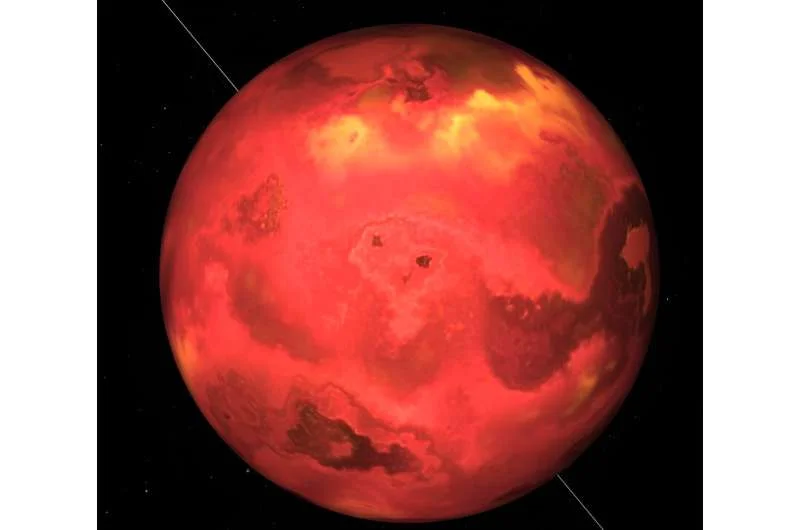Scientists have discovered Gliese 12 b, an exoplanet similar in size to Venus and only 40 light-years away. Research is ongoing to determine its atmosphere and life potential. In a rare and exciting discovery, astronomers have found an Earth-like exoplanet 40 light-years away that may be just slightly hotter than our Earth.
The potentially habitable planet, called Gliese 12 b, orbits its host star every 12.8 days, is about the size of Venus, i.e. slightly smaller than Earth, and has an estimated surface temperature of 42°C (107°F); more than most of the 5,000-odd exoplanets confirmed so far. However, this assumes there is no atmosphere, which is an important next step in determining whether it is habitable.
Atmospheric mystery Gliese 12 b
Gliese 12b’s atmosphere may be similar to Earth’s. This may be the reflection of Venus experiencing a greenhouse effect, turning it into a 400°C (752°F) hellhole. It may also have no atmosphere or a different type of atmosphere not found in our solar system.
Getting the answer is vital because it will reveal whether Gliese 12 b can maintain temperatures suitable for liquid water and possibly life on its surface, revealing answers to how and why Earth and Venus evolved so differently. Gliese 12 b is certainly not the first Earth-like exoplanet to be discovered, but NASA said there are only a handful of such worlds that deserve a closer look.
Gliese 12 b: prime target for the James Webb Space Telescope
Called the “nearest, transiting, temperate Earth-size world found to date,” this planet is a potential target for further study by the US$10 billion James Webb Space Telescope.
The closest Earth-like exoplanet to us, and perhaps the most famous, is Proxima Centauri b, only 4 light-years away. But since it’s not a transitional world, we still have a lot to learn about it, including whether it has an atmosphere and whether it has the potential for life. Most exoplanets are discovered using the transit method, in which the planet passes in front of its star from our perspective, causing the parent star’s brightness to decrease.
During the transit, starlight also passes through the exoplanet’s atmosphere and some wavelengths are absorbed. Different gas molecules absorb different colors, so the transition provides a set of chemical fingerprints that can be detected by telescopes like Webb.
The value of Gliese 12 b in the study of exoplanets
Gliese 12 b could also be important because it could help reveal whether most of the stars in our Milky Way galaxy, namely cool stars, host temperate planets that have atmospheres and are therefore habitable.
The discovery of “exo-Venus” by two international teams of astronomers was published today (May 23). Monthly Notices of the Royal Astronomical Society. It orbits a cool red dwarf star called Gliese 12, located about 40 light-years from Earth in the constellation Pisces.
Details of researchers
“Gliese 12 b is one of the best targets for studying whether Earth-sized planets orbiting cool stars can retain their atmospheres, which is a crucial step in improving our understanding of the habitability of planets in our galaxy,” said PhD student Shishir Dholakia. Center for Astrophysics at the University of Southern Queensland, Australia.
He co-led the research team with Larissa Palethorpe, a PhD student at the University of Edinburgh and University College London. The exoplanet’s host star is about 27 percent the size of our Sun, and its surface temperature is about 60 percent that of our own star.
However, the distance between Gliese 12 and the new planet is only 7 percent of the distance between the Earth and the Sun. Therefore, Gliese 12b receives 1.6 times more energy from its star than the Earth receives from the Sun, and approximately 85 percent of the energy that Venus receives.
Understanding atmospheric effects
This difference in solar radiation is important because it means that the planet’s surface temperature depends largely on atmospheric conditions. Earth’s average surface temperature is 15°C (59°F), compared to Gliese 12 b’s estimated surface temperature of 42°C (107°F).
“The atmosphere traps heat and, depending on its type, can significantly change the actual surface temperature,” Dholakia explained. “We quote the ‘equilibrium temperature’ of a planet; This is the temperature the planet would have if it had no atmosphere.
“Much of the scientific value of this planet is in understanding what kind of atmosphere it might have. Since Gliese 12b lies between the amount of light that Earth and Venus receive from the Sun, it will be valuable in bridging the gap between these two planets in our solar system.”
Palethorpe added: “The early atmospheres of Earth and Venus are thought to have been destroyed and then repopulated by volcanic outgassing and bombardment of residual material from the Solar System.
“Earth is a habitable place, but Venus is not likely to run out of water completely. Because Gliese 12b is between Earth and Venus in terms of temperature, its atmosphere can teach us a lot about how habitable planets develop.”
The researchers, along with another team in Tokyo, used observations from NASA’s Transiting Exoplanet Survey Satellite (TESS) to help with their discovery.
“We have found the closest, transiting, temperate Earth-size world to date,” said Masayuki Kuzuhara, a project associate professor at the Center for Astrobiology in Tokyo who led the research team with project assistant Akihiko Fukui. Professor at the University of Tokyo.
“Although we don’t yet know if it has an atmosphere, we thought of it as an exo-Venus with the same size and energy from the star as our neighboring planet in the Solar System.”
An important factor in maintaining the atmosphere is the turbulence of its star. Red dwarfs tend to be magnetically active, resulting in frequent and powerful X-ray bursts.
But analyzes by both teams concluded that Gliese 12 shows no signs of such extreme behavior, raising hopes that Gliese 12 b’s atmosphere is still intact.
“We know of only a handful of temperate Earth-like planets that are both close enough to us and meet other criteria for this type of study, called transmission spectroscopy, using existing instruments,” said NASA Goddard research astrophysicist Michael McElwain. He co-authored the paper with the Space Flight Center in Greenbelt, Maryland, and Kuzuhara and Fukui.
“We need more samples like Gliese 12 b to better understand atmospheric diversity and the evolutionary consequences of these planets.”
Located 40 light-years from Earth, Gliese 12b is about the same distance as the TRAPPIST-1 system. It consists of seven planets orbiting a red dwarf star, all about the same size as Earth and probably rocky.
Three of these are in the habitable zone, but at least two (and possibly all) have no atmosphere and are likely barren; They dash hopes when first discovered eight years ago that these might be aquatic worlds harboring life.













